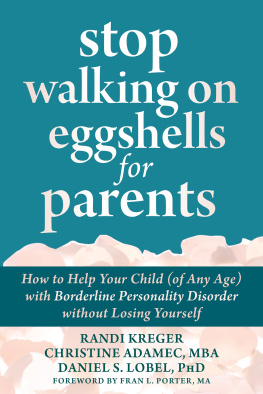The Essential Family Guide to Borderline Personality Disorder
This indispensable book is compassionate to all involved and avoids blame, jargon, and oversimplification.
Freda B. Friedman, PhD
Dialectical Behavior Specialist
With exquisite understanding of the disorder and empathy for both those who have it and their family members, Randi Kreger offers valuable Power Tools to help readers endure the ravages of BPD.
Jerold J. Kreisman, MD, coauthor of I Hate YouDont Leave Me: Understanding the Borderline Personality and Sometimes I Act
Crazy: Living with Borderline Personality Disorder
Randi Kreger uncovers the marvelous symmetry of the borderline relationship, in which both participants experience similar self-doubts, irrational guilt and shame, wavering identity, helplessness, anger, and fear of abandonment. Those with BPD and their loved ones will, together, benefit from the tools she provides.
Richard A. Moskovitz, MD, author of Lost in the Mirror:
An Inside Look at Borderline Personality Disorder
Randi Kreger masterfully breaks down BPD to help people more easily understand this complex subject.
Barbara Oakley, PhD, author of Evil Genes: Why Rome Fell,
Hitler Rose, Enron Failed, and My Sister Stole My Mothers Boyfriend
THE ESSENTIAL FAMILY GUIDE TO
Borderline Personality Disorder
New Tools and Techniques
to Stop Walking on Eggshells
Randi Kreger

Hazelden
Center City, Minnesota 55012
hazelden.org
2008 by Randi Kreger
All rights reserved. Published 2008
Printed in the United States of America
No part of this publication may be reproduced, stored in a retrieval system, or transmitted in any form or by any meanselectronic, mechanical, photocopying, recording, scanning, or otherwisewithout the express written permission of the publisher. Failure to comply with these terms may expose you to legal action and damages for copyright infringement.
Library of Congress Cataloging-in-Publication Data
Kreger, Randi.
The essential family guide to borderline personality disorder: new tools and techniques to stop walking on eggshells / Randi Kreger.
p. cm.
Includes bibliographical references and index.
ISBN 978-1-59285-363-2 (softcover)
1. Borderline personality disorderTreatment. 2. Borderline personality
disorderPatientsFamily relationships. 3. Antisocial personality disorders
Treatment. I. Title.
RC569.5.B67K73838 2008
616.85'852dc22
2008036456
Ebook ISBN: 978-1-59285-783-8
Editors note
The BPD stories quoted in this book are either composites or used with permission. In some instances, names, details, and circumstances have been changed to protect anonymity.
This publication is not intended as a substitute for the advice of health care professionals.
12 11 10 09 08 1 2 3 4 5 6
Cover design by Theresa Jaeger Gedig
Interior design by Ann Sudmeier
Typesetting by BookMobile Design and Publishing Services
Dedication
This book is for those who walked with me hand in handand sometimes carried mein my own journey along the yellow brick road. It is also dedicated to the libraries in and around Saint Louis Park, Minnesota. The childrens novels there, more precious than any ruby-red slippers, made both me and this book possible.
When we are no longer able
to change a situation...
we are challenged to change ourselves.
Viktor E. Frankl
Contents
Foreword
The Essential Family Guide to Borderline Personality Disorder is a very useful addition to the growing literature on borderline disorder (the term most acceptable to my patients and readers). The authors first book, Stop Walking on Eggshells (with Paul T. Mason), has been an international best seller in this field since its publication in 1998. A brief overview of the history and current status of borderline disorder will provide context for this guide.
Borderline disorder has been surrounded by many myths that leave people with the disorder and their family members feeling very hopeless. This should not be so because there are many actions that can be taken to markedly reduce the effects of borderline disorder on those who have it and on their families.
For almost a century, borderline disorder has been referred to as a wastebasket diagnosis, reserved for those patients whose presenting symptoms are often so complex that they do not fall cleanly into a single diagnosis, thereby frustrating the clinician, the patient, and the family. Borderline disorder is resistant to treatment with conventional uses of traditional treatment approaches, and it was not listed in the American Psychiatric Associations Diagnostic and Statistical Manual of Mental Disorders until 1980. According to the latest research, this devastating disorder has an estimated prevalence of almost 6 percent in the general population.
The many years of neglect of borderline disorder have resulted in a high prevalence of underdiagnosis, disability, continued suffering, premature death by suicide, and a deep sense of hopelessness. These overwhelming emotions pervade not only those with the disorder, but also their family members, whose lives are terribly affected. In short, borderline disorder is an overlooked, devastating disorder of tragic proportions.
Today, however, there is new hope as a convergence of factors are causing dramatic strides forward. The first factor is represented, in part, by the reports of neuroimaging studies that demonstrate clear differences in the brains of people with borderline disorder compared with those of control subjects. Other studies have demonstrated a high degree of heritability of borderline disorder, further underscoring the fact that the disorder has a significant biological basis. These studies provide clear and visible evidence that borderline disorder is associated with anatomical and functional abnormalities of the brain, and that the disorder should be viewed no differently than medical disorders affecting other organs.
The second factor is the emergence of research on the effective use of a new generation of antipsychotic agents, antidepressants, mood stabilizers, and psychotherapeutic and psychosocial interventions specifically developed for borderline disorder. Treatment programs have also been significantly effective for patients with the disorder, and they have provided highly useful information and new skills to patients families.
The third factor has been the development of two national advocacy organizations focused solely on borderline disorder: the Treatment and Research Advancements National Association for Personality Disorder (TARA APD) and the National Education Alliance for Borderline Personality Disorder (NEA-BPD). These organizations are dedicated to educating patients and their families about the disorder and how to cope more effectively with it.
The other mission of these organizations is to increase awareness of the disorder on a national and even international level and stimulate public and private funding for research and education. As a result of the efforts of the leadership of NEA-BPD, people with borderline disorder, their families, and professional experts in the field, the U.S. House of Representatives passed a resolution (H. Res. 1005) on April 1, 2008, designating the month of May as Borderline Personality Disorder Awareness Month.
In addition, other organizations have added significantly to the increase in activity in the field. For example, the National Alliance on Mental Illness (NAMI) has recently named those with borderline disorder as one of their priority populations. The Borderline Personality Disorder Resource Center has been recently established to help those affected by borderline disorder find the most current and accurate information on the nature of BPD, and on sources of available treatment.
Next page








